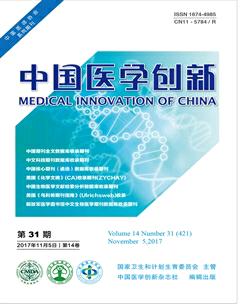体位因素对全凭静脉麻醉老年患者Narcotrend指数的影响
黄卓梅+高晓枫+汪飞
【摘要】 目的:探讨在麻醉深度不变的情况下,体位因素对全麻老年患者Narcotrend指数的影响。方法:择期全凭静脉麻醉手术患者30例,年龄60~80岁,ASAⅡ~Ⅲ级,体重指数18~24 kg/m2。麻醉诱导静脉注射舒芬太尼、丙泊酚、顺阿曲库胺,Narcotrend指数值40~45时行气管插管全凭静脉麻醉,麻醉维持予以血浆靶控输注丙泊酚和瑞芬太尼,达到稳态靶浓度后10 min时将患者调至头低脚高位(30°),记录头低体位前(T0)、頭低体位即刻(T1)、1 min(T2)、3 min(T3)、5 min(T4)和10 min(T5)时HR、MAP、Narcotrend指数值;将患者调至平卧位,10 min后再调至头高脚低位(30°),记录头高体位前(T0)、头高体位即刻(T1)、1 min(T2)、3 min(T3)、5 min(T4)和10 min(T5)时HR、MAP、Narcotrend指数值。比较同一体位不同时点、两种体位同一时间点的HR、MAP、Narcotrend指数。结果:患者头低脚高位,T2、T3、T4时MAP、Narcotrend指数分别与T0时比较均升高,差异均有统计学意义(P<0.05);患者头高脚低位,T2、T3、T4时MAP、Narcotrend指数分别与T0时比较均下降,差异均有统计学意义(P<0.05);T2、T3、T4三个相同时间点,头高脚低位患者的MAP、Narcotrend指数均低于头低脚高位患者,比较差异均有统计学意义(P<0.05)。结论:体位改变对全凭静脉麻醉老年患者Narcotrend指数可引起一过性改变,影响麻醉医师对患者麻醉深度的判断。
【关键词】 Narcotrend脑电监测; 全凭静脉麻醉; 麻醉深度; 体位; 老年人
【Abstract】 Objective:To investigate the effects of posture on the Narcotrend index in elderly patients undergoing total intravenous anaesthesia.Method:30 patients with elective total intravenous anesthesia were selected,aged 60-80 years,ASA grade Ⅱ-Ⅲ,body mass index 18-24 kg/m2.Anesthesia was induced by intravenous injection of sufentanil,propofol,cisatracurium besylate.Narcotrend index of 40 to 45 when tracheal intubation general anesthesia, anesthesia to maintain plasma target-controlled infusion of propofol and remifentanil,reaching a steady state after the target concentration of 10 min,the patients were transferred to the trendelenburg position(30 degrees),and maintained about 10 min;the patients were changed in supine position 10 min later,the position into reverse trendelenburg position were changed(30 degrees),also maintained about 10 min.Heart rate(HR),mean arterial pressure(MAP) and Narcotrend index were recorded separately at the time points of before trendelenburg position and reverse trendelenburg position(T0),immediately(T1),1 min later(T2),
3 min later(T3),5 min later(T4) and 10 min later(T5).Compared the HR,MAP and Narcotrend index of the same body position at different points and at the same time point of the two postures.Result:In the trendelenburg position,MAP and Narcotrend of T2,T3 and T4 respectively compared with T0 were increased,the differences were statistically significant(P<0.05);in the reverse trendelenburg position,MAP and Narcotrend Index of T2,T3 and T4 respectively compared with T0 were decreased,the difference were statistically significant(P<0.05);at the same time point of T2,T3 and T4,the MAP and Narcotrend index of patients with the were lower than those of patients with reverse trendelenburg position,and the difference were statistically significant(P<0.05).Conclusion:Elderly patients body position during intravenous anaesthesia can transient affect the Narcotrend index,of which will affect the anesthesiologists to judgment patients anesthesia depth.endprint
【Key words】 Narcotrend monitor; Total intravenous anesthesia; Depth of anesthesia; Posture; Elderly people
First-authors address:The First Peoples Hospital of Huizhou,Huizhou 516000,China
doi:10.3969/j.issn.1674-4985.2017.31.031
Narcotrend指數是以神经电生理技术为基础,用于监测麻醉深度的指标[1-2]。年龄、肌电活动等因素均可影响Narcotrend指数[3-5],从而影响对麻醉深度的判断。外科手术老年人患者越来越多,体位变化是手术中不可避免的问题,不同体位可影响大脑各脑室脑脊液和部位血流量的分布[6-7]。脑电双频指数(BIS)是基于神经电生理技术的麻醉深度监测指标,与Narcotrend指数具有可比性[8-9]。研究发现在麻醉深度不变的情况下,体位因素可影响BIS值[10-11],但是否会影响全麻老年患者Narcotrend指数尚有待研究。本研究拟评价在麻醉深度不变的情况下,体位因素对全麻老年患者Narcotrend指数的影响。现报道如下。
1 资料与方法
1.1 一般资料 选取2016年3-12月在惠州市第一人民医院择期行全麻手术患者30例。纳入标准:年龄60~80岁,ASA Ⅱ~Ⅲ级,体重指数18~24 kg/m2,无药物过敏史,无严重呼吸系统疾病及肝肾功能异常。排除标准:病窦综合征、心动过缓、Ⅱ度以上房室传导阻滞者;有严重高血压、冠心病者;有神经和精神疾病病史者;术前24 h内使用镇静药者;血红蛋白(Hb)<100 g/L者。本研究已获本院伦理委员会批准,并与患者及家属签署知情同意书。
1.2 方法 无术前用药,入室后开放外周静脉,静脉滴注6%羟乙基淀粉130/0.4注射液。连接IntelliVue MP30型监测仪(Philips公司,荷兰)监测ECG、HR、MAP、SpO2,EN60601型Narcotrend麻醉/脑电监护系统(Schiller公司,德国)监测Narcotrend指数:清洁患者前额皮肤,按要求放置Narcotrend专用电极片,确保Narcotrend监测仪连接后皮肤电阻低于4 kΩ。平卧位麻醉诱导:依次静脉注射舒芬太尼0.4 μg/kg、丙泊酚2~4 mg/kg、顺阿曲库胺0.15 mg/kg,Narcotrend指数值40~45时行气管插管,连接Fabius麻醉机(Draeger 公司,德国)行机械通气,VT 8~10 mL/kg,RR 10~13次/min,维持呼气末二氧化碳(PETC02)35~40 mm Hg。麻醉维持:TCI丙泊酚,血浆靶控浓度为2 μg/mL;TCI瑞芬太尼,血浆靶控浓度为1 μg/mL。达到稳态靶浓度后10 min时将患者调至头低脚高位(30°),记录头低体位前(T0)、头低体位即刻(T1)、1 min(T2)、3 min(T3)、5 min(T4)和10 min(T5)时HR、MAP、Narcotrend指数;将患者调至平卧位,10min后再调至头高脚低位(30°),记录头高体位前(T0)、头高体位即刻(T1)、1 min(T2)、3 min(T3)、5 min(T4)和10 min(T5)时HR、MAP、Narcotrend指数。如MAP下降幅度超过基础值30%时静脉注射麻黄碱6 mg;MAP上升幅度超过基础值30%时静脉注射亚宁定10 mg,HR低于50次/min时静脉注射阿托品0.3 mg;HR大于120次/min时静脉注射艾司洛尔2 mg。
1.3 统计学处理 使用SPSS 17.0统计软件进行分析,计量资料以(x±s)表示,不同时间比较采用重复测量设计方差分析,组间比较采用t检验,以P<0.05为差异有统计学意义。
2 结果
试验过程中因有3例患者使用了麻黄碱、阿托品而剔除。患者头低脚高位,T2、T3、T4时MAP、Narcotrend指数分别与T0时比较均升高,差异均有统计学意义(P<0.05);患者头高脚低位,T2、T3、T4时MAP、Narcotrend指数分别与T0时比较均下降,差异均有统计学意义(P<0.05),见表1。两种体位同一时间点HR、MAP、Narcotrend指数比较,T2、T3、T4三个相同时间点,头高脚低位患者的MAP、Narcotrend指数均低于头低脚高位患者,比较差异均有统计学意义(P<0.05),见表1。
3 讨论
本研究采用靶控输注丙泊酚和瑞芬太尼麻醉,保持相同的血浆靶控效应室浓度,而且均在手术开始前对同一患者进行观察,变换3种不同体位,监测Narcotrend指数,排除了由于个体差异、麻醉深度及手术因素,同时排除术中使用心血管活性药物对Narcotrend指数的影响,由于严重高血压、冠心病、神经和精神疾病病史、术前24 h内使用镇静药均可能影响Narcotrend指数,所以本研究排除以上患者,可得Narcotrend指数的改变主要受体位变化的影响。年龄因素对Narcotrend指数也有一定影响[12-13],外科手术老年患者越来越多,而体位变化是手术中不可避免的问题,本研究仅选取观察对象年龄60~80岁的老年患者。Narcotrend指数通过对原始脑电的采集分析,分为6个级别(A~F)和14个亚项,每个亚项均对应一定的数值,从0~100反映患者从清醒到深度麻醉的整个过程。本研究结果表明,头低位后5 min内患者Narcotrend指数值升高,但级别并没有发生改变,且改变体位后10 min时已恢复体位改变前水平;头高位后5 min内患者Narcotrend指数值下降,但级别并没有发生改变,且改变体位后10 min时已恢复体位改变前水平;T2、T3、T4三个相同时点,头高脚低位患者的MAP、Narcotrend指数均低于头低脚高位患者(P<0.05),可见体位改变对全凭静脉麻醉老年患者Narcotrend指数有一过性影响,且与血压改变呈正相关,其原因推测与不同体位下生理改变有关。一方面,根据脑血流的自动调节机制,MAP在一定范围内的升高可增加脑血流灌注,此外研究表明,头低脚高位可增加颅内压、眼内压及大脑中动脉的血流速度[14-15],直立位时大脑各部位的血流及各脑室的脑脊液均减少[16-17],因此,Narcotrend指数的变化可能与体位改变引起脑血流变化有关。另一方面,脑血流分布的变化可使脑电活动和对应的脑电波形的偶极子发生改变[18]。文献[19]表明,与体位相关的脑电图变化主要来源于颞回部,当脑皮质远离内测颅骨时,脑电图的振幅将减小,而Narcotrend指数源自于脑电活动,极有可能受此影响,故Narcotrend指数的变化也可能与体位引起的脑皮质与颅骨间距变化有关。endprint
本研究觀察对象是年龄60~80岁,对于另外一些患者群体,如小儿、年龄60岁以下或80岁以上、神经外科手术患者,体位对Narcotrend指数有何影响还有待进一步研究。综上所述,体位改变对全凭静脉麻醉老年患者Narcotrend指数可引起一过性改变,影响麻醉医师对患者麻醉深度的判断。
参考文献
[1]梅莉,万朝权.Narcotrend监测用于老年人小肠镜检查的临床研究[J].国际麻醉学与复苏杂志,2014,35(4):305-308.
[2]曾蓉,雷勇静,刘小彬.Narcotrend在老年人喉罩全麻纤支镜检查中的应用[J].国际麻醉学与复苏杂志,2013,34(8):699-701.
[3] Münte S,Klockars J,van Gils M,et al.The Narcotrend index indicates age-related changes dring propofol induction in children[J].Anesth Analg,2009,109(1):53-59.
[4] Panousis P,Heller A.R,Burghardt M,et al.The effects of electromyographic activity on the accuracy of the Narcotrend monitor compared with the Bispectral Index during combined anaesthesia[J].Anaesthesia,2007,62(9):868-874.
[5]谭玮,罗爱林.肌电活动对Narcotrend和脑电双频谱指数监测右美托咪啶镇静深度的影响[J].国际麻醉学与复苏杂志,2013,34(3):202-205.
[6] Alperin N,Lee S H,Mazda M,et al.Evidence for the importance of extracranial venous flow in patients with idiopathic intracranial hypertension(IIH)[J].Acta Neurochir Suppl,2005,95:129-132.
[7]张禹琦,李玉兰,陈军.妇科腹腔镜手术中Trendelenburg体位时脑血流动力学的变化[J].临床麻醉学杂志,2015,31(5):436-438.
[8] Kreuer S,Bruhn J,Larsen R,et al.Comparability of Narcotrend index and bispectral index during propofol anaesthesia[J].Br J Anaesth,2004,93(2):235-240.
[9]刘妃妃,岳云,高建东.Narcotrend指数与七氟醚吸人麻醉患者麻醉深度的相关性:与BIS值的比较[J].中华麻醉学杂志,2013,33(8):972-974.
[10]朱小兵,吴论,刘志群,等.体位因素对全凭静脉麻醉患者脑电双频指数的影响[J].临床麻醉学杂志,2013,29(7):708-709.
[11]钟燕婷,吴论,朱小兵,等.熵指数与脑电双频指数监测全麻患者体位变化时镇静深度的比较[J].现代仪器与医疗,2017,23(1):64-67.
[12]马玲,陈桂英,杨凡,等.不同年龄患者意识消失时丙泊酚的用量[J].临床麻醉学杂志,2015,31(6):546-549.
[13]纪浩聪,黄卓梅,杨骥云.Narcotrend与BIS监测在患儿七氟醚吸入麻醉的比较[J].临床麻醉学杂志,2015,31(2):139-140.
[14] Geinas J C,Marsden K R,Tzeng Y C,et al.Influence of posture on the regulation of cerebral perfusion[J].Aviat Space Environ Med,2012,83(8):751-757.
[15] Molloy B L.Implications for postoperative visual loss:steep trendelenburg position and effects on intraocular pressure[J].Aana J,2011,79(2):115-121.
[16]王宏伟,钟泰追.头高位对糖尿病并发自主神经病变患者全麻下脑血流速度的影响[J].中华麻醉学杂志,2012,32(3):314-316.
[17]程傲冰,许立新,余守章,等.15°头高脚低位对脑肿瘤全麻手术患者血流动力学和脑氧代谢的影响[J].广东医学,2012,33(10):1442-1444.
[18] Kreuer S,Wilhelm W.The Narcotrend monitor.Best Pract Res Clin Anaestbesiol[J].2006,20(1):11-119.
[19] Schneider S,Brummer V,Camahan H,et al.What happens to the brain in weightless?A first approach by EEG tomography[J].Neuroimage,2008,42(4):1316-1323.endprint

